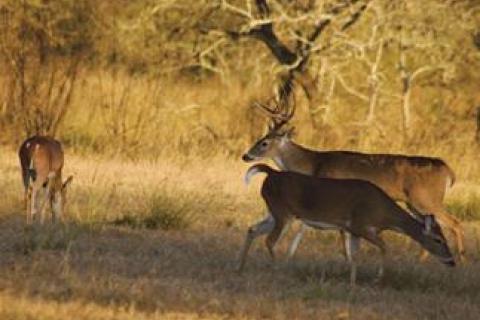
We’re told in countless articles and blogs to deer hunt near doe groups as the rut approaches. But the real key to success is to find the right doe group.
 |
| You can tell when does are in estrous. They become more edgy, often looking back over their shoulders. And their tails may stick straight out or be crooked to the side. |
Different clusters of does, even in a small hunting area, can cycle at slightly different times. If they didn’t, the main estrous period would last about 1½ days, instead of 7 to 10 days. By finding a doe group that’s cycling or just about to, you can up your chances of success.
Mature bucks monitor the status of females constantly as peak rut approaches. While visiting the different doe groups, they watch for visual signs and sniff for pheromones that tell them exactly which doe group is ready and which ones are a few days away.
It may sound like a small difference, but if you sit near a group of does that won’t mate for another three days, you could have a long, cold wait. And you could be missing hot action taking place around another group just a quarter-mile away.
Using this knowledge that different doe groups cycle at different times has helped me immensely in hunting my home territory. I know that a herd in a cool, higher elevation part of the property always seems to breed early, so I set up there for my first rut hunts.
Once they finish a group that holds near a prime feed area in the lowlands comes next. They are followed by a couple of herds scattered throughout the middle part of the property. The scenario plays out over a full week or more, allowing me to stretch the rut hunt out and be in the right place at exactly the right time.
Once you pinpoint such a pattern on your hunting land, you can use it to make a schedule for future years on where to expect the rut to kick in at various times.
Even if you hunt different areas and it’s not practical to work out a “rut schedule” for cycling does, being aware of the signs of when a particular doe group is coming into heat and likely to attract bucks will definitely enhance your hunting success.
Factors For Predicting Which Doe Groups Will Cycle First
There are several climate and habitat conditions that will help you predict which area’s does will cycle earlier or later. And there are behavioral and posture traits that will tip you off on whether does are close to cycling when you encounter them.
First of all, if one part of the property you hunt is cooler than another because of elevation, those does may tend to cycle first. Check out the highest ridges and peaks for the earliest breeding females.
Lacking any measurable temperature differences, look to the deer habitat quality. Where are the most desirable foods and best living quarters located? The oldest doe and her offspring will typically claim that spot, and she will often cycle before younger does.
Find the location with the best feed and also good nearby cover in the form of low brush such as plum thickets, tall grasses, scattered trees and edible shrubs such as honeysuckle, blackberry, olive, greenbrier, and raspberry. That’s where the oldest and earliest cycling does should be. Expect the herds hanging around less desirable food sources to breed later.
How to Spot Does in Estrous
You can tell when a doe is ready by her behavior. As their hormones build up and they approach estrous, does become restive, pacing more. They often look back over their shoulders and their tails may stick straight out or be crooked to the side.
If the animals you see look relaxed and mostly interested in food, with no nervousness or edgy demeanor, search for another group.
Once you find a doe that looks ready, hunt downwind of her bedding area or between there and the closest feed spot. You’ve pinpointed the hottest doe group, and that’s where the biggest bucks in the area are going to be for the next few days.
Check out the deer rut heat map to see how the season is progressing in your area at Bass Pro Shops 1Source.
- 2996 views

